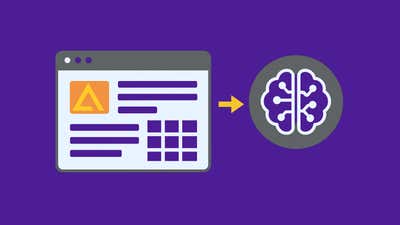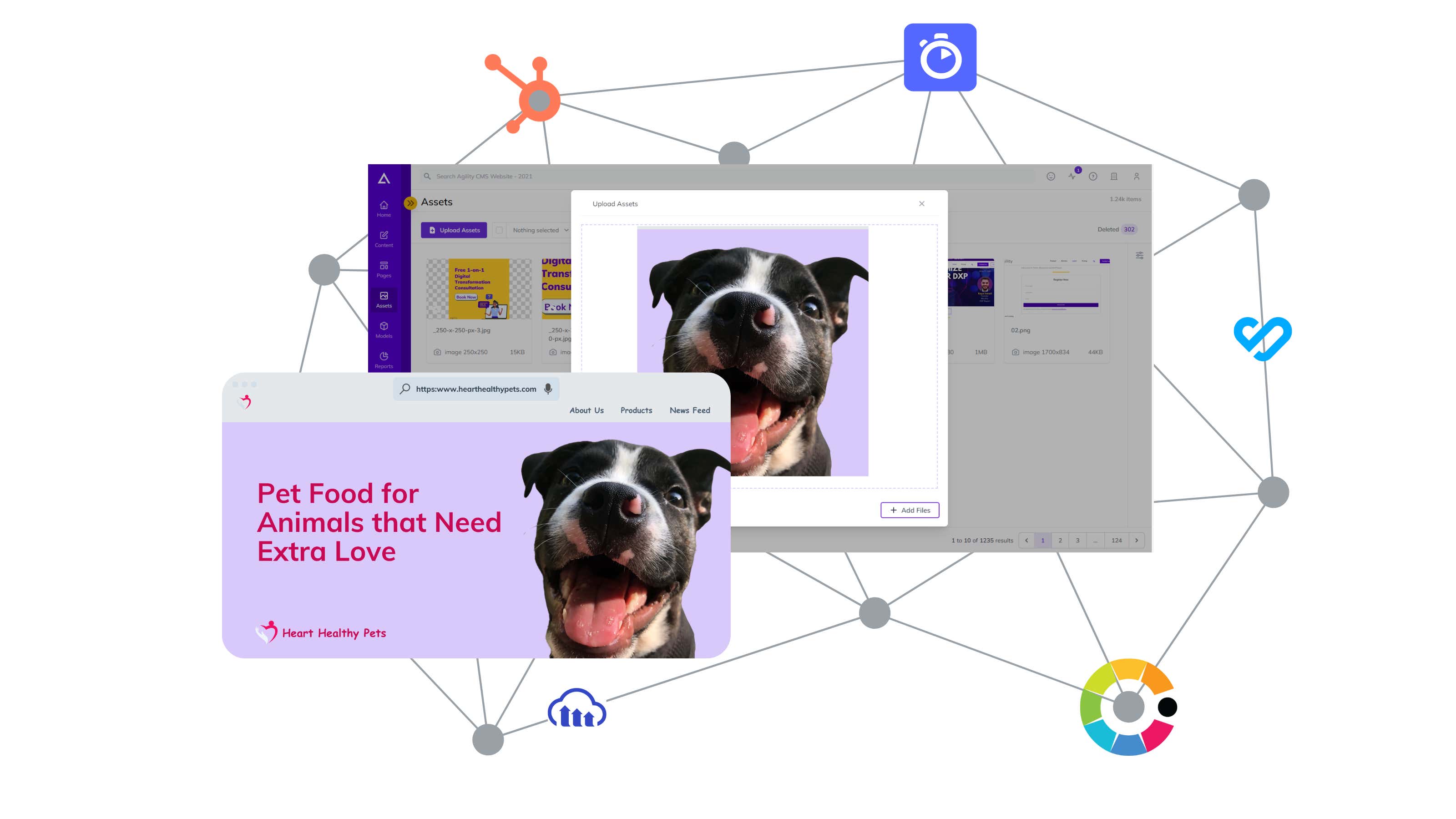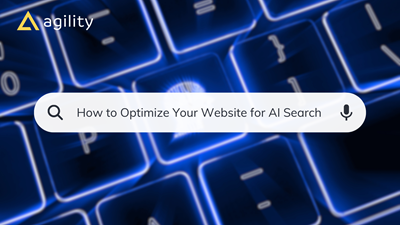Built for GEO: How Structured Content from Agility CMS Future-Proofs Your Website for AI Discovery
Helpful how-to tips to structure your content in the age of AI


Welcome to the age of Generative Engine Optimization (GEO), where traditional SEO for modern websites – while still necessary – is no longer enough.
What is GEO?
GEO is the practice of creating content for AI tools such as ChatGPT, Gemini, and Claude which don’t exclusively rely on traditional search engine crawlers.
The rise of AI-powered search has been extraordinary. Look at these numbers (US unless otherwise noted):
- In 2023, 13 million users used AI for search. That number is expected to reach 90 million by 2027.
- It took Google approximately one year to surpass one million searches per day. It took ChatGPT five days to reach one million users.
- 60% of web searches conclude without users clicking to other websites. A large portion of users are now using AI Search summaries.
Generative search engines are transforming the way users interact with the web. These systems aren’t simply keyword-driven. They rely on structured, contextual, and semantically rich content to produce relevant results.
Let’s take a closer look at how this is done.
1. Structured Content for LLM Ingestion

To appear in AI-generated answers, your content needs to be machine-readable and well-defined. This is where structured content – which can be found in a headless CMS platform like Agility CMS – comes in.
Structured content breaks information into consistent, reusable fields. For example:
- Blog posts use consistent fields like title, author, sub-title, date, etc.
- Product descriptions use product_name, features, use_cases, pricing, etc.
What you’ll notice is that each field only contains a single piece of information. Those are called atomic fields (think of atom = one; an example being title vs. title_author).
This makes it easier for Large Language Models (LLMs) to:
- Parse and understand content.
- Generate accurate, context-rich answers.
- Ingest and retrieve information instantly.
With structured content, you’re not hoping AI “figures it out” because you’re telling it, through the content you create and components you use, exactly what it needs to know.
Here’s Something Interesting
LLMs are primarily consuming content from HTML, which offers a wealth of semantic context, but is often not leveraged in many situations.
With structured content from Agility CMS, all the semantic and contextual cues that HTML allows for – including OpenGraph, meta tags, and JSON-LD – can be outputted into the HTML page.
Now the LLMs, whether they are crawling your content for their initial knowledge or indexing it for live lookups, can glean far more information from it.
2. Headless CMS for AI: Flexibility for Search Optimization Across Channels
Traditional gateways into your website and brand’s content include search engine results pages (SERPs), app content, and social media posts. GEO has joined the party in the form of:
- AI assistants that summarize and synthesize content to answer user queries directly.
- Chat interfaces that can recommend brands, provide product information, or reveal insights in a conversational flow.
- Voice search where structured responses are required.
- Industry-specific copilots (healthcare, finance, etc.) trained on specialized knowledge bases on web content.
These new gateways are essentially front-end channels which require content that’s modular, contextual, and consistent.
With a headless CMS solution like Agility, structured content is decoupled from presentation and delivered via APIs. This means you can:
- Deliver the same content to different frontends with zero duplication.
- Customize formatting and structure per channel while maintaining brand and messaging consistency.
- Publish consistently to provide a steady stream of content for AI to ingest and deliver.
Ultimately, this creates a single source of truth for content across all channels. No matter where your content appears – on a SERP or in an AI summary – it will be consistent, brand-aligned, and optimized for consumption.
3. Composability for AI Results

Agility CMS embraces composable content creation. Your content, design components, and logic are modular and reusable.
This is critical for AI results. AI can often combine or repurpose content from multiple sources to create context. Because of this, it must make sense on…
- …the web, and…
- …mobile devices, and…
- …voice queries, and…
- …chatbots, and…
…in every other context where AI may surface your content.
Composable content ensures a paragraph from a blog can be used as a stand-alone AI snippet. Or a product spec sheet can be combined with customer case studies in an AI summary. Or voice assistants can read a feature list without the rest of the page.
The more places your content appears – and the more consistently it’s structured – the more AI will pick up on it and use it correctly.
A structured approach directly impacts how and when AI displays your content. Let’s see how this all comes together with a simple use case.
Real World Use Case: GEO
Imagine a potential customer asking an AI assistant this question: “What are the benefits of a headless CMS for enterprises?”
With a traditional website, the assistant may grab a vague paragraph which doesn’t have enough context or text from an outdated blog.
With structured content in Agility CMS, AI can pull exactly the right information – such as enterprise_benefits, use_cases, and industries_served – and deliver it in the right context, every time.
Helpful How-To Tips
Content for GEO and AI Discovery
Q: How can you optimize content for GEO?
A: Structure your content into reusable, atomic fields within a headless CMS like Agility CMS. Ensure each field contains one piece of information (title vs. title_author). This allows AI models to parse and serve accurate answers in any context.
Q: How can you ensure AI assistants find your website content?
A: Use structured content, semantic HTML, and metadata (OpenGraph, JSON-LD) so LLMs can index content accurately for generative search results.
Structured Content for LLM Ingestion
Q: How to make website content easier for AI to understand?
A: Break content into clearly defined, atomic fields. Use consistent naming conventions for similar content types, and output semantic markup in your HTML so AI tools can extract meaning.
Q: How to use Agility CMS to create structured content?
A: Model your content types with discrete fields (e.g. product_name, features, use_cases) and use Agility's APIs to deliver this structure to all channels.
Q: How to ensure AI uses the right information from your website?
A: Include relevant context in your structured fields and metadata. AI won't have to guess, it will pull exactly what you've defined.
Multi-Channel AI Optimization
Q: How to deliver content to both traditional and AI-driven channels?
A: Use a headless CMS to separate content from presentation. Publish once, then distribute the same structured content to websites, apps, chatbots, and voice assistants via APIs.
Q: How to make content voice-search ready?
A: Provide structured, concise responses in your CMS fields so voice assistants can retrieve and read them without extra context.
Composable Content for AI Results
Q: How to make content reusable across different AI contexts?
A: Create modular, composable content blocks in your CMS so snippets, paragraphs, or lists can stand alone and still make sense in AI summaries.
Q: How to ensure product and blog content works for AI?
A: Structure product specs, benefits, and case studies separately so AI can mix and match them to answer specific user queries.
A Quick Recap (Maybe AI Will Pick This Up): AI Reads Structured Content
Every AI gateway is an opportunity for your brand to be discovered.
The caveat: Only if your content can reach it.
Structured content and API-driven delivery make it possible to:
- Optimize snippets for AI crawlers and indexers.
- Deliver structured data to voice interfaces and chatbots.
- Supply up-to-date content to custom AI copilots and internal tools.
AI is here and growing in popularity. Depending on your viewpoint, you might think AI could be the death knell for traditional websites. Or not. Or it will change how the web looks and works.
What’s not up for debate is that AI is an opportunity to scale your reach. With Agility CMS, you can reduce the effort required to do it.
Learn More
Here are some helpful resources
- Why Do Marketing Leaders Love Structured Content – Benefits for editors and creators.
- Understanding Structured Content – How to use structured content in content modeling.
- What is Structured Content – Great for beginners.
And if you want to see Agility CMS in action, here’s how:
AI is rewriting the rules of discoverability. With Agility CMS, you can make sure your content is not only found, but understood, trusted, and used in exactly the right context.

About the Author
Joel is CTO at Agility. His first job, though, is as a father to 2 amazing humans.
Joining Agility in 2005, he has over 20 years of experience in software development and product management. He embraced cloud technology as a groundbreaking concept over a decade ago, and he continues to help customers adopt new technology with hybrid frameworks and the Jamstack. He holds a degree from The University of Guelph in English and Computer Science. He's led Agility CMS to many awards and accolades during his tenure such as being named the Best Cloud CMS by CMS Critic, as a leader on G2.com for Headless CMS, and a leader in Customer Experience on Gartner Peer Insights.
As CTO, Joel oversees the Product team, as well as working closely with the Growth and Customer Success teams. When he's not kicking butt with Agility, Joel coaches high-school football and directs musical theatre. Learn more about Joel HERE.
View Related Resources

How to Optimize Your Website for AI Search

How Artificial Intelligence is Converting the E-commerce Industry

